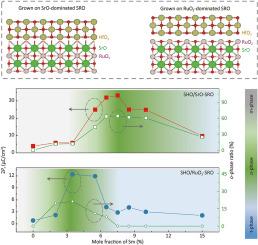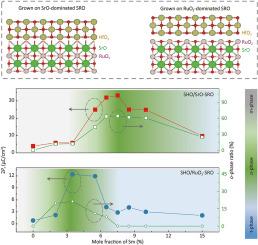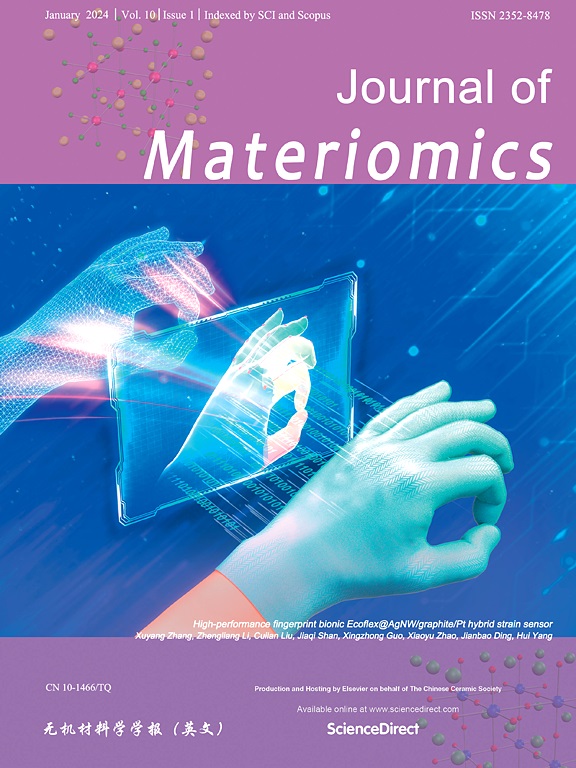基于电荷平衡协同策略掺杂HfO2/SrRuO3薄膜异质结构的工程相变和铁电性能
IF 9.6
1区 材料科学
Q1 CHEMISTRY, PHYSICAL
引用次数: 0
摘要
在HfO2中,正交相的稳定是基于铪的铁电器件的关键。在这里,我们提出了一种电荷平衡协同策略来调节受体掺杂HfO2薄膜异质结构的相变和优化铁电性能。采用sm掺杂HfO2/SrRuO3异质结构为平台,受体在掺杂浓度控制的HfO2中引入额外空穴,SrRuO3电极通过末端控制的表面功函数注入电子。随着Sm浓度的增加,观察到从单斜相到正交相再到四方相的转变。提高铁电性的sm掺杂区域取决于SrRuO3的终止。这些行为归因于异质结构中受体掺杂和界面注入相结合的电荷平衡效应。因此,HfO2晶格中的空穴被调制成主要分布在特定的氧亚晶格上,降低了单斜相和正交相之间的相对能量。我们还将研究扩展到其他受体掺杂的HfO2,如La3+和Eu3+,并观察到几乎相同的相变和铁电行为。我们的研究结果为正交相的稳定提供了更多的物理见解,并通过利用异质结构系统中的电极结构和HfO2基层,为设计高性能铁电HfO2器件开辟了新的途径。本文章由计算机程序翻译,如有差异,请以英文原文为准。


Engineering phase transition and ferroelectric properties in acceptor-doped HfO2/SrRuO3 thin-film heterostructures by a charge-balance synergistic strategy
In HfO2, the stabilization of orthorhombic phase is crucial for hafnia-based ferroelectric devices. Here, we propose a charge-balance synergistic strategy to modulate phase transition and optimize ferroelectric properties in acceptor-doped HfO2 thin-film heterostructures. Sm-doped HfO2/SrRuO3 heterostructures are adopted as the platform, in which the acceptor introduces extra holes into the HfO2 controlled by doping concentration, while the SrRuO3 electrode injects electrons depended on termination-controlled surface work function. Transition from monoclinic to orthorhombic and then to tetragonal phase is observed with increasing Sm concentration. The Sm-doping region for improved ferroelectricity is found to be depended on SrRuO3 termination. These behaviors are ascribed to the charge-balance effect that combines the acceptor doping and the interface injection in the heterostructures. The holes in HfO2 lattices are thus modulated to dominantly distribute on specific oxygen sublattices, lowering the relative energy between monoclinic and orthorhombic phases. We also extend the study into other acceptor-doped HfO2, such as La3+ and Eu3+, and observe almost identical phase transition and ferroelectric behaviors. Our findings provide more physical insights into the stabilization of orthorhombic phase and open a new gateway for designing high-performance ferroelectric HfO2 devices by harnessing both the electrode structures and the HfO2-based layers in heterostructure systems.
求助全文
通过发布文献求助,成功后即可免费获取论文全文。
去求助
来源期刊

Journal of Materiomics
Materials Science-Metals and Alloys
CiteScore
14.30
自引率
6.40%
发文量
331
审稿时长
37 days
期刊介绍:
The Journal of Materiomics is a peer-reviewed open-access journal that aims to serve as a forum for the continuous dissemination of research within the field of materials science. It particularly emphasizes systematic studies on the relationships between composition, processing, structure, property, and performance of advanced materials. The journal is supported by the Chinese Ceramic Society and is indexed in SCIE and Scopus. It is commonly referred to as J Materiomics.
 求助内容:
求助内容: 应助结果提醒方式:
应助结果提醒方式:


